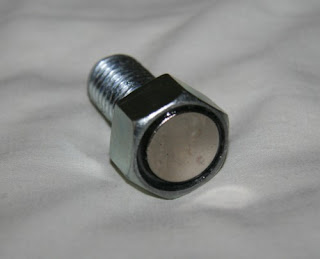Nano's are small caches about the size of the tip of your pinkie finger. Magnetized on one end, they can fit in spots that many caches cannot even fit in and they are inconspicous. Commonly, they are found in urban environments where someone wants to place a cache but most caches won't fit well. For those who haven't seen one, here is what a nano looks like (with a penny for scale):
 But a nano in the woods? I must be crazy. Well, I won't deny that statement but I will ask that you give me a chance to explain. It is entirely possible to place a nano in the woods without people crying for your capture. It just takes the right cache design. The design I'm going to share today can be varied as you desire, but it is one I have been working on for a while now. Let's look at what is needed.
But a nano in the woods? I must be crazy. Well, I won't deny that statement but I will ask that you give me a chance to explain. It is entirely possible to place a nano in the woods without people crying for your capture. It just takes the right cache design. The design I'm going to share today can be varied as you desire, but it is one I have been working on for a while now. Let's look at what is needed. First and foremost, you need a nano. You can find them through many various geocaching stores, along with Groundspeak's own store. They do cost a few dollars, and occasionally you can find deals if you buy a group of them.
Once you have the nano, the next thing you need is an ammo can. Yep, I said ammo can. You might be starting to see where this is going.
With these two items, you have the bare minimum needed for this cache. Place the nano inside the empty ammo can and go find a good spot in the woods to hide the ammo can. Cacher's will dread your nano and possibly give a huge sigh of relief, and maybe confusion, when they find the ammo can. But, as always, there is a way to go an extra step. This is where my design comes in.
 For my idea, I've been spending the last several months trading swag for golf balls whenever I see one in a cache. My idea, which you are welcome to use and modify if desired, is to get as many golf balls as my ammo can will hold. I'm closing in on that goal. Many are dirty so I'll take one day and clean them all up so they look as similar as possible short of brand design. I've purposely passed up on colorful golf balls.
For my idea, I've been spending the last several months trading swag for golf balls whenever I see one in a cache. My idea, which you are welcome to use and modify if desired, is to get as many golf balls as my ammo can will hold. I'm closing in on that goal. Many are dirty so I'll take one day and clean them all up so they look as similar as possible short of brand design. I've purposely passed up on colorful golf balls.Next, I will begin the process of drilling out a hole in one of the golf balls. The hole will need to be deep enough that I can fit a nano inside such that only the lid of the nano sticks out. Then I need just a tad bit deeper. This is so I can glue a magnet into the base of the hole. I could stick the nano in further, but if I do, it will make it harder for geocachers to pull the nano out of the hole. With the magnet in place, I can set the nano into the hole and voila...geocachers now have to search the ammo can for the golf ball that contains the nano. You can see an example of how this would look to the left.
This is an idea that can be modified however you desire. I've actually seen a variation with a homemade container for the nano to be housed in. Don't want to use golf balls? 35mm film canisters can also work. Just place a small pebble in each one so that a geocacher can't "feel" the containers for the one with the nano.
And that is how to place a nano in the woods that won't resort in your exile.
TripCyclone






